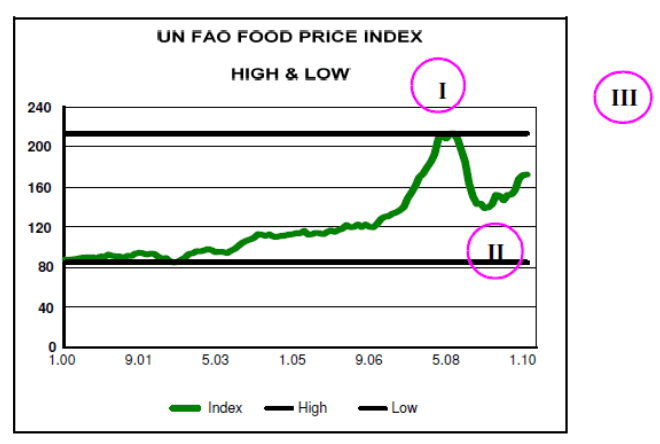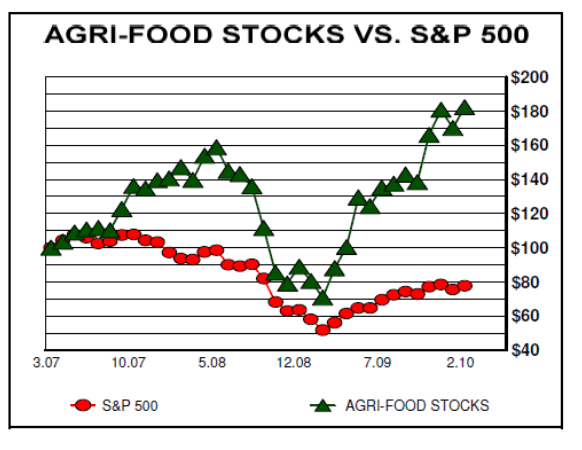Agri-Food Stocks Greatly Outperforming the Stock Market Indices
Commodities / Agricultural Commodities Mar 01, 2010 - 08:08 PM GMTBy: Ned_W_Schmidt
 We continue to periodically hear, or read, the word commodities flow from the mouths, or the keyboards, of those not very well informed. By now, China was to be in the midst of a massive recession and commodity prices were to be selling for a pittance. Rather, what we learned is that the gurus of the Street really know little or nothing of China or commodities. We wonder how iron ore prices at 18 month highs fit into those forecasts.
We continue to periodically hear, or read, the word commodities flow from the mouths, or the keyboards, of those not very well informed. By now, China was to be in the midst of a massive recession and commodity prices were to be selling for a pittance. Rather, what we learned is that the gurus of the Street really know little or nothing of China or commodities. We wonder how iron ore prices at 18 month highs fit into those forecasts.
So many strategists fail to understand that, one, China is a complex, heterogeneous nation. Further, commodities is not a homogenous asset class. Commodities is really comprised of three groups: Energy, Minerals, and Agri-Food. Each has different economic drivers, and their correlation with each other is actually closer to being somewhat random. In short, any discussion of "commodity investing" is the mark of a gathering of the uninformed.

Our first chart this week, above, is of the food price index produced by the UN Food & Agricultural Organization(FAO). The horizontal black lines delineate the high and low on that index for the last ten years. Note that prior to 2008 was a clear break out from the historical trend. The rally to the 2008 high, in part artificially induced by the hedge fund mania, had been in the making for some time, perhaps as much as five years. The low of 2009, importantly, was above the highs recorded prior to 2008.
As time progresses from left to right on that graph, we can make some fairly strong statements about Agri-Food demand. First, the population of the world is larger now than 10 years ago. Second, the sum of that population is eating more food, each and ever day. As a consequence of those factors, Agri-Food prices seem to have become more volatile in recent years.
That demand is greater and Agri-Food prices are more volatile means that the world is now living in the price inelastic portion of the long run Agri-Food supply curve(Agri-Food Value View, February & March, 2010). In such an environment, the percentage increase in Agri-Food prices will be greater than the percentage change in the supply of Agri-Food. That condition lays the foundation for the unfolding of Wave III in Agri-Food prices, as marked on the graph.
A benefit of higher Agri-Food prices is that revenues for those involved in the entire Agri-Food production chain will be higher. Those higher prices will flow to the farmers, those that provide goods and services to them, and the accumulators that gather the harvests from the farmers before passing it on to the consumers. That chart clearly portrays a new situation in which demand is dominant, and that pricing power has shifted to the Agri-Food producers.

Among the beneficiaries of permanently higher Agri-Food prices are all those companies involved in that industry. Our second chart, above, portrays the performance of a group of Agri-Food stocks versus the general market. The beauty of the results portrayed should be obvious to the casual observer. While the next year will certainly not be as exciting as the past year for Agri-Food stocks, the same probably can be said for the stock market in general. Longer term prospects, however, for the Agri-Food sector are quite positive due to the price inelasticity of Agri-Food supply.
Pull up any of the major business media web sites or listen to any of the cable business shows. One still hears talk of technology stocks, though they have been dead money for ten years. Banks, most of which are still trying to shrink their loans, continue to receive attention. The reason for that is baffling as the market rarely, if ever, returns a formerly popular group to renewed popularity. But, do you read or hear of Agri-Food and the stocks of that sector?
Market inefficiencies offer investors an opportunity. When information about an economic sector is not widely disseminated or written about, a market inefficiency may exist. As investors are not being fully informed, valuations may be rewarding. Investments may exist that offer benefits to those that turn their attention away from the popular drivel. With Wave III for Agri-Food prices unfolding, as indicated in the above chart, and information inefficiency widespread, investors might improve their wealth situation by exploring Agri-Food. One place to start is: www.agrifoodvalueview.com
By Ned W Schmidt CFA, CEBS
AGRI-FOOD THOUGHTS is from Ned W. Schmidt,CFA,CEBS, publisher of The Agri-Food Value View , a monthly exploration of the Agri-Food grand cycle being created by China, India, and Eco-energy. To receive the most recent issue of this publication, use this link: http://home.att.net/~nwschmidt/Order_AgriValue.html
Copyright © 2010 Ned W. Schmidt - All Rights Reserved
Ned W Schmidt Archive |
© 2005-2022 http://www.MarketOracle.co.uk - The Market Oracle is a FREE Daily Financial Markets Analysis & Forecasting online publication.



